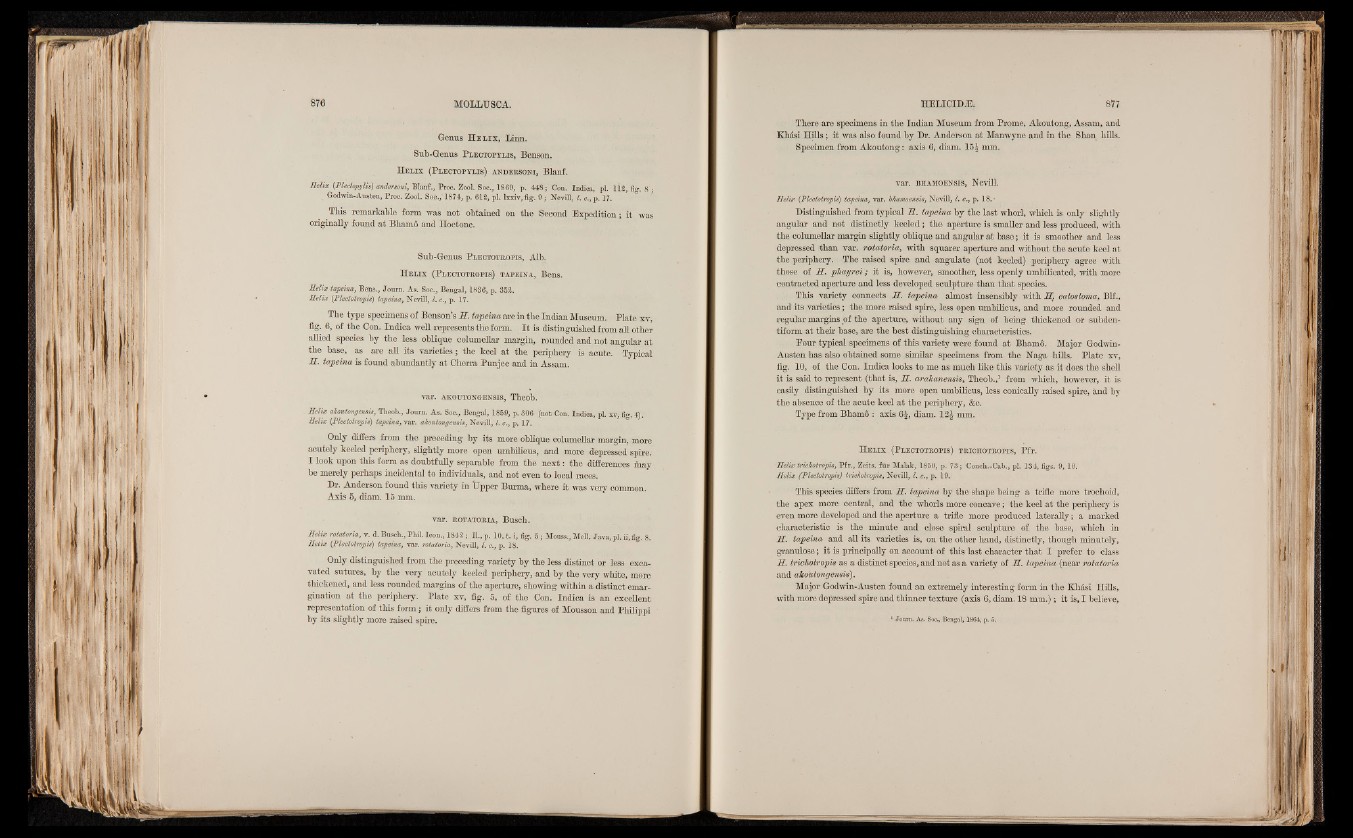
Genus H e l ix , Linn.
Sub-Genus P l e c t o p y l i s , Benson.
H e l i x ( P l e c t o p y l i s ) a n d e r s o n i , Blanf.
Helix (.Plectopylis) andersoni, Blanf., Proc. Zool. Soc., i869, p. 448; Con. Indica, pi. 112, fit*. 8 ;
Godwin-Austen, Proc. Zool. Soe./1874, p. 612, pi. lxxiv,fig. 9; Nevill, I. c., p. 17.
This remarkable form was not obtained on the Second Expedition; it was
originally found at Bham6 and Hoetone.
Sub-Genus P l e c t o t r o p is , Alb.
H e l i x ( P l e c t o t r o p is ) t a p e in a , Bens.
Helix tapeina, Bens., Joum. As. Soc., Bengal, 1886, p. 852.
Helix (Plectotropis) tapeina, Nevill, I. c., p. 17.
The type specimens of Benson’s 3 . tapeina are in the Indian Museum. Plate x y ,
fig. 6, of the Con. Indica well represents the form. I t is distinguished from all other
allied species by the less oblique columellar margin, rounded and not angular at
the base, as are all its varieties; the keel at the periphery is acute. Typical
3 . tapema is found abundantly at Cherra Punjee and in Assam.
var. a k o u t o n g e n s i s , Theob.
Helix akoutongensis, Theob., Joum. As. Soc., Bengal, 1859, p. 806 (not Con. Indica, pi. xv, fig. 4).
Helix (.Plectotropis) tapeina, var. akoutongensis, Nevill, I. c., p. 17.
Only differs from the preceding by its more oblique columellar margin, more
acutely keeled periphery, slightly more open umbilicus, and more depressed spire.
I look upon this form as doubtfully separable from the next: the differences may
be merely perhaps incidental to individuals, and not even to local races.
Dr. Anderson found this variety in Upper Burma, where it was very common.
Axis 5, diam. 15 mm.
var. r o t a t o r ia , Busch.
Helix rotatoria, v. d. Busch., Phil. Icon., 1842¡jg ||p . 10, t. i, fig. 5; Mouss., Moll. Java, pi. ii, fig. 8.
Helix {Plectotropis) tapeina, var. rotatoria, Nevill, I. c., p. 18.
Only distinguished from the preceding variety by the less distinct or less excavated
sutures, by the very acutely keeled periphery, and by the very white, more
thickened, and less rounded margins of the aperture, showing within a distinct emar-
gination at the periphery. Plate xv, fig. 5, of the Con. Indica is an excellent
representation of this form; it only differs from the figures of Mousson and Philippi
by its slightly more raised spire.
There are specimens in the Indian Museum from Prome, Akoutong, Assam, and
Khàsi Hills ; it was also found by Dr. Anderson at Manwyne and in the Shan hills.
Specimen from Akoutong : axis 6, diam. 15 £ mm.
var. b h a m o e n s i s , Nevill.
Helix {Plectotropis) tapeina, var. bhamoensis, Nevill, I. c., p. 18. •
Distinguished from typical R. tapema by the last whorl, which is only slightly
angular and not distinctly keeled; the aperture is smaller and less produced, with
the columellar margin slightly oblique and angular at base; it is smoother and less
depressed than var. rotatoria, with squarer aperture and without the acute keel at
the periphery. The raised spire and angulate (not keeled) periphery agree with
those of 3 . phayrei ; it is, however, smoother, less openly umbilicated, with more
contracted aperture and less developed sculpture than that species.
This variety connects R . tapeina almost insensibly with JET. catostoma, Blf.,
and its varieties; the more raised spire, less open umbilicus, and more rounded and
regular margins p i the aperture, without any sign of being thickened or subden-
tiform at their base, are the best distinguishing characteristics.
Eour typical specimens of this variety were found at Bhamd. Major Godwin-
Austen has also obtained some similar specimens from the Naga hills, Plate xv,
fig. 10, of the Con. Indica looks to me as much like this variety as it does the shell
it is said to represent (that is, II. araJca/nensis, Theob.,1 from which, however, it is
easily distinguished by its more open umbilicus, less conically raised spire, and by
the absence of the acute keel at the periphery, &c.
Type from Bhamd : axis 6^, diam. 12^ mm.
H e l i x ( P l e c t o t r o p i s ) t r ic h o t r o p i s , Pfr.
Helix trichotropis, Pfr., Zeits. fur Malak, 1850, p. 78; Coneh.-Cab., pi. 134, figs. 9, 10.
Helix (Plectotropis) trichotropis, Nevill, l..c., p. 19.
This species differs from 3 . tapeina by the shape being a trifle more trochoid,
the apex more central, and the whorls more concave; the keel at the periphery is
even more developed and the aperture a trifle more produced laterally; a marked
characteristic is the minute and close spiral sculpture of the base, which in
H. tapema and all its varieties is, on the other hand, distinctly, though minutely,
granulose; it is principally on account of this last character that I prefer to class
S . trichotropis as a distinct species, and not as a variety of 3 . tapeina (near rotatoria
and akoiitongensis).
Major Godwin-Austen found an extremely interesting form in the Kh&si Hills,
with more depressed spire and thinner texture (axis 6, diam. 18 mm.); it is, I believe,
• Journ. As. Soc., Bengal, 1864, p. o.